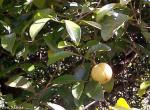juma (gueule de bois)
Myristica fragrans(dans les territoires avec usage significatif TRAMIL)
Usages significatifs TRAMIL noix, en poudre, voie orale1 |
Recommandations
Préparation et posologie Références |
Selon l’information disponible : L’emploi contre les maux de tête, la “gueule de bois” et la pneumopathie est classé REC sur la base de l’usage traditionnel significatif documenté dans les enquêtes TRAMIL et les études de toxicité. Si l’état du patient se détériore, ou si les maux de tête ou la “gueule de bois” durent plus de 2 jours, ou si la pneumopathie persiste au-delà de 5 jours, consulter un médecin. La pneumopathie étant dangereuse pour la santé, il est recommandé de consulter un médecin au préalable. L’emploi de cette ressource doit être considéré comme un complément au traitement médical, sauf contre-indication. Ne pas ingérer plus de 500 mg/jour de poudre de noix pour un adulte. Ne pas employer avec des femmes enceintes ou allaitantes, ni avec des enfants de moins de 3 ans. |
La noix de Myristica fragrans constitue un condiment de consommation humaine relativement répandu. Travail TRAMIL25 Contre la gueule de bois (vertiges ou la faiblesse d’origine éthylique) : Toute préparation médicinale doit être conservée au froid et utilisée dans les 24 heures. |
1 GERMOSEN-ROBINEAU L, GERONIMO M, AMPARO C, 1984 2 JEAN-PIERRE L, 1988 3 CHARLES C, 1988 4 NUÑEZ MELENDEZ E, 1964 5 SCHENK H, LAMPARSKY D, 1981 6 JANSSEN AM, CHIN NLJ, SCHEFFER JJC, BAERHEIM-SVENDSEN A, 1980 7 SUSUKI H, HARADA M, 1990 8 ORABI KY, MOSSA JS, EL-FERALY FS, 1991 9 MATSUMOTO A, MATSUMOTO T, TOKUDA H, 1991 10 HOSTETTMANN K, LEA P (Eds.), 1987 11 DUKE JA, ATCHLEY AA, 1986 12 OZAKI Y, SOEDIGDO S, WATTIMENA YR, SUGANDA AG, 1989 13 ICHIKAWA K, KINOSHITA T, SANKAWA U, 1989 14 WESLEY-HADZIJA B, BOHING P, 1956 15 MORII L, 1987 16 PAZOS L, COTO T, CAIZA F, 2009 17 MOKKHASMIT M, SWATDIMONGKOL K, SATRAWAHA P, 1971 18 CARR CJ, 1973 19 DUKE J, 1985 20 TRUITT EB, CALLAWAY E, BRAUDE MC, KRANTZ JC, 1961 21 BARTLETT B, 1911 22 JOHNSON J, 1906 23 STAGER J, WUTHRICH B, JOHANSSON SG, 1991 24 CODE OF FEDERAL REGULATIONS, 2002 25 CARBALLO A, 1995 |
